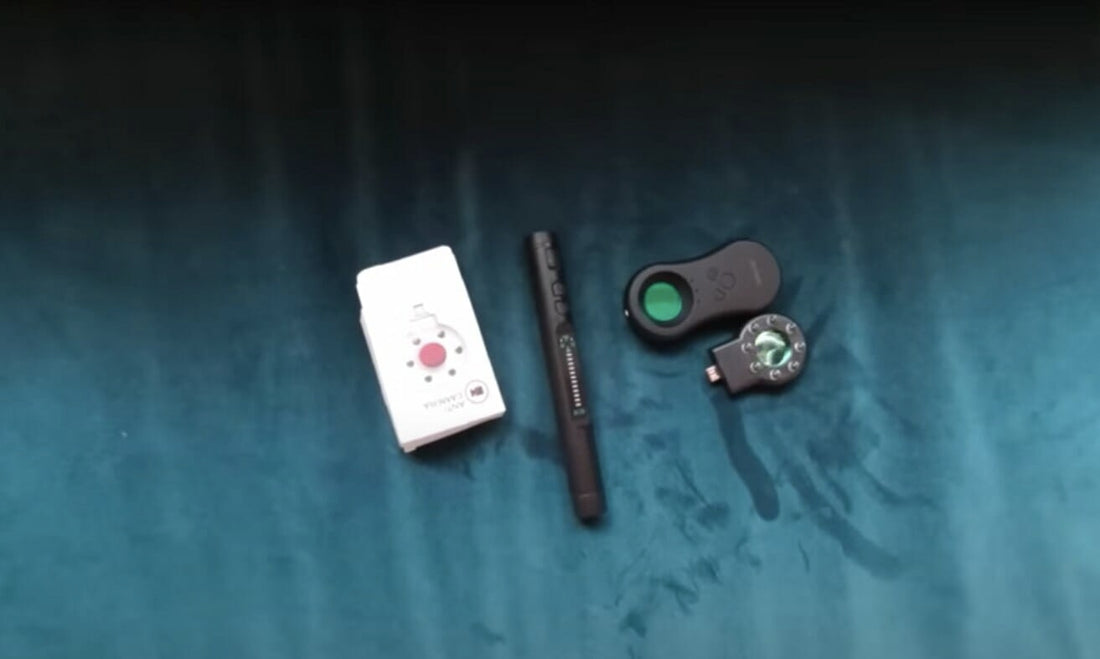
How Hidden Camera Detectors Work: A Quick Guide
Share
Whether at home or in public, the idea of being secretly filmed can be quite disturbing. But how can you determine if a concealed camera exists around you?
This is where hidden camera detection devices come into play. These gadgets utilize cutting-edge technology to search for concealed cameras or recording equipment within a room. They function by identifying the electromagnetic radiation emitted by such devices, which the detector can then recognize.
In this article, we will delve deeper into the workings of hidden camera detectors and examine the various detection devices available for purchase.
Additionally, we will offer guidance on using a detector efficiently and share some real-world instances where these gadgets have assisted people in discovering concealed cameras in their homes or workplaces.
How Hidden Camera Detectors Work
Have you ever found yourself in a scenario where it seemed someone could be observing you? Hidden cameras can be found in all sorts of places, from public restrooms to hotel rooms. Thankfully, there are devices available that can assist you in identifying them. In this segment, we will examine the functioning of hidden camera detectors more closely.
Types of Hidden Camera Detectors
Two primary categories of hidden camera detectors exist those with wires and those that are wireless.
Wired Detectors

Wired detectors are linked to a power supply and can identify cameras connected to a power source.
Wireless Detectors

Wireless detectors operate on battery power and can identify cameras not connected to an electrical source.
Various detectors employ distinct technologies to discover concealed cameras. Some devices utilize infrared technology to detect the heat emitted by a camera, while others rely on radio frequency (RF) technology to identify signals transmitted by wireless cameras.
How Hidden Camera Detectors Detect Cameras

Hidden camera detectors function by identifying the electromagnetic signals emitted by cameras. These signals can be detected using various technologies, depending on the type of detector.
For example, RF detectors scan for the frequency range wireless cameras use. When a camera is detected, the detector will alert you with an audible or visual signal.
Infrared detectors, on the other hand, work by detecting the heat given off by a camera. When a camera is detected, the detector lights up or makes a sound.
Limitations of Hidden Camera Detectors
While hidden camera detectors can be useful, they do have their limitations. For example, they may be unable to detect cameras hidden behind walls or other obstacles.
Additionally, some cameras may be designed to emit signals difficult for detectors to pick up. It’s also important to note that hidden camera detectors are not foolproof. They may give false positives or false negatives, and they may not be able to detect all types of cameras.
Components of a Hidden Camera Detector

Detection Range
Another crucial aspect to consider is the detection range of a hidden camera detector. It is essential to have a detector capable of identifying concealed cameras from an adequate distance. Opt for a detector with a minimum detection range of 10 feet or greater. This guarantees your ability to locate hidden cameras while maintaining a safe distance.
Usability
The user-friendliness of a hidden camera detector is equally significant. It’s essential to have a detector that is simple to operate and doesn’t necessitate any particular skills or expertise. Search for a detector with straightforward and understandable instructions. It should be easily understood and used, even by those new to the process.
Battery Life
Another vital factor when choosing a hidden camera detector is its battery life. It’s essential to have a detector with a long-lasting battery, guaranteeing you won’t run out of power during crucial moments. Opt for a detector with a battery life of at least 8 hours or more.
When selecting a hidden camera detector, strive to find one that is fairly priced, provides an appropriate detection range, is easy to use, and possesses a long battery life. By evaluating these elements, you can pinpoint a detector that fulfills your needs and protects your privacy.

So, there you have it – the inner workings of a hidden camera detector. Although numerous hidden camera detectors are available in the market, they all operate on the fundamental principle of identifying the electromagnetic radiation emitted by wireless cameras. These devices can swiftly and effortlessly locate concealed cameras in your residence or workplace using radio frequency and infrared detection.
Naturally, no hidden camera detector is infallible, and there will always be some cameras that manage to evade detection. However, by investing in a top-notch detector and adhering to basic guidelines for avoiding concealed cameras, you can substantially diminish the likelihood of being surveilled without your consent.
Thanks for reading, and be sure to check out our other articles for more great tech insights and reviews!
Resources
Organizations:
- Electronic Frontier Foundation (EFF) – https://www.eff.org/
- Privacy International – https://privacyinternational.org/
Websites:
- Krebs on Security – A blog by Brian Krebs focused on internet security, privacy, and cybercrime: https://krebsonsecurity.com/
Video References:
National Geographic
Liron Segev
Best Product
How helpful was this post?
